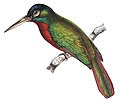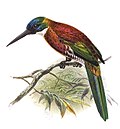Loading AI tools
Genus of birds From Wikipedia, the free encyclopedia
Galbula is the type and largest genus of the jacamar family (Galbulidae) of piciform birds, and its suborder Galbulae. Sometimes, the Piciformes are split in two, with the Galbulae upranked to full order Galbuliformes.[1]
| Galbula Temporal range: Miocene-Recent | |
|---|---|
 | |
| Adult female rufous-tailed jacamar (Galbula ruficauda melanogenia) | |
| Scientific classification | |
| Domain: | Eukaryota |
| Kingdom: | Animalia |
| Phylum: | Chordata |
| Class: | Aves |
| Order: | Piciformes |
| Family: | Galbulidae |
| Genus: | Galbula Brisson, 1760 |
| Type species | |
| Alcedo galbula Linnaeus, 1766 | |
| Species | |
|
10, see text | |
The genus was introduced by the French zoologist Mathurin Jacques Brisson in 1760 with the green-tailed jacamar (Galbula galbula) as the type species.[2][3] The name galbula is the Latin word for a small yellow bird.[4]
They are smallish to mid-sized forest birds of the Neotropics, with long pointed bills, elongated tails, and small feet. Colored in metallic iridescent hues – typically greenish – at least on the upperside, some have a red or brownish belly. Males and females are generally similar in appearance, but in most species differ in minor plumage details. As usual for Piciformes, they nest in burrows they dig out themselves. In the case of this genus, nests are dug in earthen banks along rivers or roads, or in termitaria. As with other jacamars but otherwise unknown among Piciformes, their chicks do not hatch naked. They have a piping song and feed in typical jacamar fashion, by catching flying arthropods, typically larger insects such has butterflies.[1]
Most Galbula species are fairly common in their natural range, which despite rampant deforestation is still extensive. Only the coppery-chested jacamar (G. pastazae) occurs in a more restricted region in the Andes foothills, and is considered a threatened species.[1]
Ten living species are presently recognized in this genus:[5]
| Image | Scientific name | Common Name | Distribution |
|---|---|---|---|
 | Galbula albirostris | Yellow-billed jacamar | Brazil, Colombia, French Guiana, Guyana, Suriname, and Venezuela |
 | Galbula cyanicollis | Blue-necked jacamar | Amazon rainforest of Brazil, far northern Bolivia and eastern Peru |
 | Galbula ruficauda | Rufous-tailed jacamar | southern Mexico, Central America and South America as far south as southern Brazil and Ecuador |
 | Galbula galbula | Green-tailed jacamar | Brazil, Colombia, French Guiana, Guyana, Suriname, and Venezuela |
 | Galbula pastazae | Coppery-chested jacamar | southern Colombia, Ecuador and far northern Peru |
 | Galbula cyanescens | Bluish-fronted jacamar | western Amazon Basin of Brazil, Peru and far northwestern Bolivia. |
 | Galbula tombacea | White-chinned jacamar | Amazon Basin of Colombia, Amazonas and northern parts of Ecuador and Peru |
 | Galbula chalcothorax | Purplish jacamar | western Amazon Basin of Ecuador, Peru, southern Colombia and western parts of Acre and Amazonas |
 | Galbula leucogastra | Bronzy jacamar | Bolivia, Brazil, Colombia, French Guiana, Guyana, Suriname, and Venezuela |
 | Galbula dea | Paradise jacamar | Bolivia, Brazil, Colombia, Ecuador, Peru and the Guyanas |
A fossil species, Galbula hylochoreutes, has been described from the mid-Miocene of Colombia. It was apparently more specialized for aerial feeding than the living species.[6]
Seamless Wikipedia browsing. On steroids.
Every time you click a link to Wikipedia, Wiktionary or Wikiquote in your browser's search results, it will show the modern Wikiwand interface.
Wikiwand extension is a five stars, simple, with minimum permission required to keep your browsing private, safe and transparent.